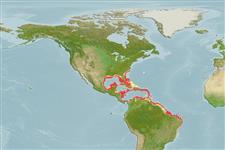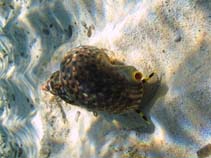Charonia variegata (Lamarck, 1816)
Atlantic triton's trumpet| Native range | All suitable habitat | Point map | Year 2050 |

|
| This map was computer-generated and has not yet been reviewed. |
| Charonia variegata AquaMaps Data sources: GBIF OBIS |
Classification / Names Common names | Synonyms | CoL | ITIS | WoRMS
| Littorinimorpha | Ranellidae
Environment: milieu / climate zone / depth range / distribution range Ecología
Asociado a arrecife; rango de profundidad 1 - 384 m (Ref. 83934). Tropical; 34°N - 17°S, 97°E - 0°E (Ref. 83435)
Distribución Países | Áreas FAO | Ecosistemas | Ocurrencias, apariciones | Introducciones
Western Atlantic and the Mediterranean.
In the past identified as Charonia tritonis in the Mediterranean.
Length at first maturity / Tamaño / Peso / Age
Maturity: Lm ? range ? - ? cm Max length : 37.4 cm DL macho / no sexado; (Ref. 83435); common length : 33.0 cm TL macho / no sexado; (Ref. 355)
Short description Morfología
Shell elongate, large, heavy. Spire pointed, elongate. Anterior canal very short. Varices present on last whorls. Parietal region with narrow dark brown inner lip covered by regularly spaced, spirally oriented, white, cord-like plicae. Outer lip internally with pairs of fine white teeth superimposed on square blotches of dark brown colour. Colour: cream white with brown markings, usually crescent-shaped.
This species is found shallow subtidal (Ref. 355), and on offshore coral reefs and cienaga facies, particularly on algae, boulder, coral, rock, sand and shell habitats (Ref. 83934).
Life cycle and mating behavior Madurez | Reproducción | Puesta | Huevos | Fecundidad | Larva
Members of the order Neotaenioglossa are mostly gonochoric and broadcast spawners. Life cycle: Embryos develop into planktonic trocophore larvae and later into juvenile veligers before becoming fully grown adults.
Main reference
Referencias | Coordinador | Colaboradores
Leal, J.H. 2003. (Ref. 355)
IUCN Red List Status (Ref. 130435)
CITES status (Ref. 108899)
Not Evaluated
CMS (Ref. 116361)
Not Evaluated
Threat to humans
Human uses
Pesquerías: comercial
| FishSource |
Herramientas
Más información
Países
Áreas FAO
Ecosistemas
Ocurrencias, apariciones
Introducciones
Stocks
Ecología
Dieta
componentes alimenticios
Áreas FAO
Ecosistemas
Ocurrencias, apariciones
Introducciones
Stocks
Ecología
Dieta
componentes alimenticios
Fuentes de Internet
BHL | BOLD Systems | CISTI | DiscoverLife | FAO(Publication : search) | Fishipedia | GenBank (genome, nucleotide) | GloBI | Gomexsi | Google Books | Google Scholar | Google | PubMed | Árbol de la vida | Wikipedia (Go, búsqueda) | Expediente Zoológico
Estimates based on models
Preferred temperature
(Ref. 115969): 17.9 - 27.1, mean 23.8 (based on 157 cells).
Price category
(Ref. 80766):
Unknown.



